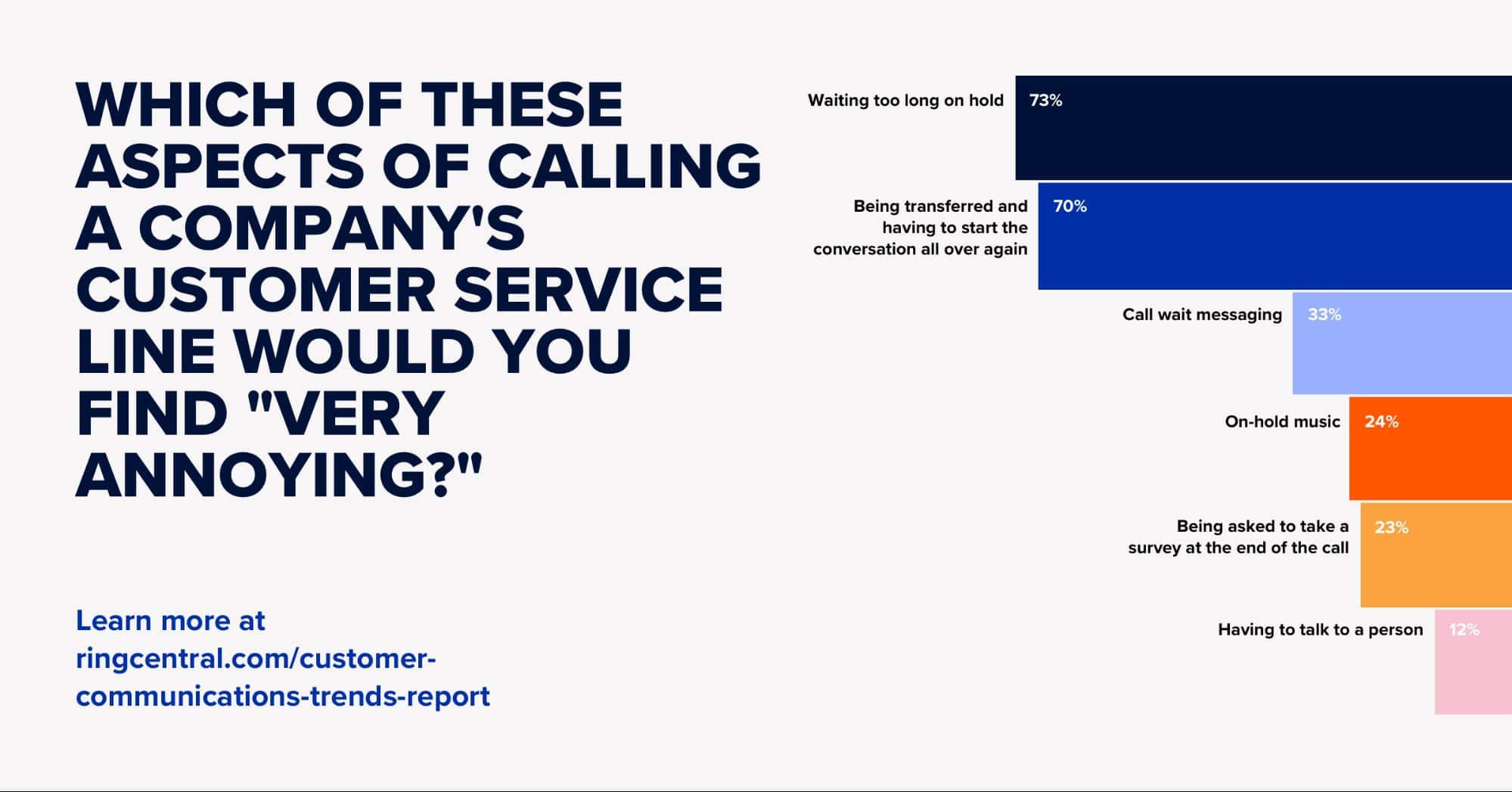It’s no secret that call centers are concerned with metrics and performance.
Reps have to be fast at not only picking up the phone and responding to customers, but also solving those issues—sometimes, even when they’re quite complex. Hey, life isn’t always fair.
That’s exactly why you can’t ignore your call center’s average handle time (AHT).
From avoiding lengthy hold-times to making sure that your customer service team is actually having productive conversations, your average handle time is crucial if you want to respect the schedules of your customers and employees alike.
In this guide, we’ll break down everything you need to know about AHT and how to measure it. We’ll also delve into the actionable ways to speed up your customer communications—that won’t require you to reinvent the wheel.
In this post, we’ll look at:
- What is average handle time, anyway?
- What’s considered a “good” average handle time
- What utilization rate is and how to use it
- Why average handle time is so important to a call center
- What causes a slow average handle time
- 8 ways to slash your contact center’s average handle time
Learn about the damage that long hold times can do, and what customers expect from call or contact centers today.
What is average handle time (AHT), anyway?
Average handle time (AHT) measures the average duration of time it takes for an agent to resolve a service call from beginning to end. This includes hold-times, actual conversations with customers, and any necessary follow-ups.
Although AHT typically refers to service calls, the metric also applies to communication via email, social media, or live chat.
Basically, average handle time represents the average amount of time (in second or minutes) required for an agent to consider a call “complete.” You can measure AHT either per agent or across an entire contact center.
How is average handle time calculated?
Good question. Here’s an average handle time formula that we can work with:
(Time on hold + time talking to customers + time spent following up) / (# of calls completed)
The easiest way to track average handle time without having to calculate it by hand is through call monitoring and analytics features in your contact center platform, which does all the hard work for you.
Given everything on your agents’ plates, manual call-logging probably isn’t an ideal use of their time. Remember: they should be empowered to build relationships with customers, not deal with repetitive low-value tasks.
Keep in mind the distinction between average handle time and average hold time. The second one measures how long a customer waits on hold before their call is answered. Here’s an average hold time formula for reference: (# of minutes or seconds customers spend on hold) / (# of calls completed).
What’s considered a “good” average handle time?
The short answer? It depends.
If you’re looking for an average handle time industry standard for reference, data from Call Centre Helper Magazine’s Erlang calculator1 takes real-world data from hundreds of thousands of calls to come up with a working average:

According to their sample data, AHT for call centers sits somewhere around six minutes. However, this doesn’t take into account variables like industry and team size.
[ebook-download title=”How customer-obsessed is your business?” link=”https://netstorage.ringcentral.com/documents/quiz_how_customer_obsessed_your_business.pdf” cta-text=”Take the quiz” src=””]
In fact, this is what makes average handle time a tricky metric to track. Call centers aren’t all making their numbers readily available, meaning that you might have to use your own benchmarks and internal data.
There are quite a few variables that impact your average handle time.
- Team size: Smaller teams that can’t handle a larger volume of calls or messages are going to have higher average handle times, spending more time on hold or in-between calls.
- Departments: From marketing and sales to accounts receivable and beyond, different departments may tend to have longer (or shorter) calls that skew your average handle time.
- Industry: For example, a SaaS company selling a service with tons of complicated features will likely have a longer handle time than a retail business that primarily handles billing and shipping questions.
Also, service calls shouldn’t be seen as a matter of “quantity over quality.” Agents shouldn’t sacrifice customer satisfaction just for the sake of quicker calls. The goal here is to find ways to become more efficient, not micromanage your agents to the point where they’re trying to sprint through their conversations.
The takeaway? There is no “right” AHT.
That said, you should continuously strive to find new ways to make your call center more efficient. Research from Forrester2 notes that average handle time increased by 11% from 2013 to 2016, suggesting that there’s room for improvement for call center agents who are arguably busier than ever.
What about utilization rate?
If you’re concerned about productivity and efficiency at your call center, your team’s utilization rate is another metric to watch in addition to AHT.
Utilization rate measures the amount of time that agents actively spent logging and conducting calls compared to the rest of their tasks. Here’s a calculation of a sample utilization rate:
[(# of hours logging calls) / (total hours per week)] x 100
For example, an agent who spends 30 hours logging calls during a 40-hour workweek would have a utilization rate of 75%.
What is a good utilization rate for a call center?
Much like average handle time, what makes a “good” utilization rate is up for debate.
For example, the previously mentioned Cell Centre Helper Magazine says that a strong utilization rate is around 80% (and anything above that is approaching burnout). Meanwhile, older research3 suggests that a rate of 60–70% is approaching burnout.
Although every business wants to get more done in less time, there’s no denying that burnout is a massive problem—and reps aren’t going to perform at their best when they’re run ragged. Consider that your team may have other tasks (including meetings and training) that may impact their utilization rate.
Why is average handle time so important to a call center?
According to recent research by Gartner4, meeting customer expectations goes hand in hand with long-term loyalty. You want your customers to stick around.
And to meet those needs, you need to prioritize speed in your live customer service channels—like phone calls, which are still preferred by the average consumer. In a survey of US consumers, phone calls were either the most popular communication channel or a very close-second favorite for customers who want to communicate with a business after buying from them:
Beyond that, companies should strive to eliminate obvious annoyances to customers such as long hold-times, unnecessary back-and-forth, and so on.
Looking specifically at your average handle time helps you focus on uncovering inefficiencies and have more productive conversations with customers—a win-win for both your agents and customers.
What causes a slow average handle time?
So, why do so many call centers lag behind when it comes to AHT? Let’s take a look at some of the most common culprits.
Lack of omnichannel contact routing
This is the big one. Call centers quite literally can’t afford to “wing it” when it comes to accepting their customers’ preferred methods of communication or routing calls to the right reps. (Learn more bout automated customer service and how it can help with this.) Not to mention this cuts down on unnecessary holds and makes sure that customers receive personalized service.
This is why tools such as omnichannel contact routing are a must-have for call centers today. WIth a constant pulse on which agents are available and what’s been logged, it’s so much easier to spot where your agents are winning (and where they can improve). Here’s how RingCentral’s solution looks, for example:
Tangents and time-wasting
Finding the balance between relationship-building and just shooting the breeze can be tough. Your team obviously wants to get to know your customers, but conversations about the weather aren’t exactly the best use of your time.
Similarly, many outbound and inbound call centers incorporate unnecessarily long greetings and sign-offs that add to their handle times, which could be better spent getting down to business.
Sure, you don’t want your agents to be cold or curt. That said, you should strive to respect the time of your employees and your customers.
Repeat calls and redundant information
Food for thought: 70% of people surveyed in the 2020 Customer Communications Review said that being transferred and having to repeat themselves all over again is a “very annoying” part of calling companies:
Having this shared information readily accessible is quickly becoming a customer service best practice. Plus, if someone has to call you back multiple times or repeat information that could’ve been logged in your customer history, your average handle time is going to suffer.
8 ways to slash your contact center’s average handle time
Want to improve your average handle time? The following tactics are a good place to start.
1. Step up your call center training for new and struggling agents
Maybe the best way to trim down your AHT is by making a conscious effort to train all of your agents to become more efficient from the word “go.”
Here are some points to emphasize when you’re onboarding new hires to speed up your handle times:
- Familiarize agents with your product and service with demos, webinars, and blog posts; doing this helps them spend less time later looking up answers to questions they should already know.
- Recommend and practice call handling techniques (think: quick greetings, close-ended questions).
- Allow your new (and struggling) agents to shadow your existing support staff.
- Review and roleplay the scenarios that most often result in lengthy and complicated calls (think: confused or angry customers).
- Allow your agents to ask questions and collaborate with each other.
The last point is especially important as we’re seeing more and more companies hire remote call center staff. With communication tools like RingCentral, you can encourage more effective teamwork through channels like messaging and video calls.
This is a great way of letting your agents share advice, resources, and customer feedback with you more proactively during the training process:
2. Empower your reps with scripts for common customer questions
Despite popular belief, using scripts for customer service doesn’t necessarily mean robotic or “one-size-fits-all” support.
Scripts are fantastic tools for efficiency when it comes to dealing with common questions or concerns, particularly over email or social media.
Let’s say you sell software that has a particularly complex feature that often confuses your customers. By having a script or templated reply handy, you can provide faster answers to your customers without having to come up with a response from scratch every time.
Scripts can also become second nature to agents over the phone, ultimately making them more knowledgeable about your service in the long run.
3. Gather relevant information before hopping on a customer call
The more you know about your customers before a call, the better.
Remember what we said earlier about redundant questions and repeat information? Ideally, you should have your customers’ history and contact information front and center as soon as you pick up the phone. If nothing else, this information should be easy to look up.
For example, customer intake forms (like this one from Box.com) allow you to understand key details about customers or leads to better route them and serve them based on which agents are available.

Even better? Use a CRM that stores your customer interactions. Here’s an example using Zoho CRM (which integrates with RingCentral to show a pop-up with your customer’s information on the screen when you’re prepping for a call):
With a CRM, you can see how long someone’s been a customer, which products they’re using, and who they’ve spoken to in the past. This allows you to route customers to agents they already know and trust, leading to fewer introductions and less repeat information relayed.
4. Make sure you’re routing calls to the right agents
The importance of this is two-fold.
For starters, customers should be automatically routed to the right departments (think: sales, accounts receivable) to avoid being bounced around or needlessly transferred.
Not only that, your agents should also be receiving an appropriate number of inbound calls based on their availability, skill-level, and overall call volume.
A new agent stuck with handling angry customers or in-depth problems that would be better suited for a veteran team member is not an ideal situation. This is exactly how your average handle time gets skewed. We’d recommend using skills-based call-routing to make sure your customers are routed to agents in a way that results in shorter wait times and faster resolutions.
5. Model what an effective call actually sounds like
Pop quiz: do you agents know what a “good” call sounds like?
Giving your agents real recordings and transcripts (RingCentral does both!) of some of your best agents’ calls lets you both reinforce your training and prove that positive, timely calls aren’t just a pipe dream.
These recordings can be part of your training program or reference resources that your team can review on their own time.
Another added bonus of using RingCentral is the ability to conduct in-depth call and speech analysis. For example, the platform can uncover successful phrases and procedures used in agent calls through AI:
6. Build out your knowledge base and self-service resources
With customer resources and an in-depth knowledge base, you’re basically empowering customers to try to answer their own questions before reaching out to you for a call.
Knowledge bases are awesome for not only helping customers diagnose problems but also providing agents with resolutions to product questions they may not already be familiar with.
For example, companies like Dyson, Campaign Monitor, and Zendesk boast a variety of guides and videos that take customers step by step through potential problems. Pointing to your knowledge base is both time-efficient and straightforward for agents, especially those working with customers via chat or email:

7. Let analytics guide your support strategy
Having all of your call center metrics and customer service KPIs in one place is key to improving your AHT.
In fact, RingCentral’s analytics portal actually features an average handle time analysis:

With a dedicated analytics tool and dashboard, you can understand how your agents and company at large are performing. Want to know who’s handling the most calls? Interest in the average calls per hour in a call center? With RingCentral, you don’t have to second-guess the answers. Having these numbers available provides a clear roadmap for where you and your agents can improve.
🕹️ Get a hands-on look at how RingCentral works by booking a product tour:
8. Regularly communicate performance and expectations to your agents
Piggybacking on the last tip, you can’t expect reps to improve their AHT until they know what’s expected of them. Highlighting performance data and expectations is crucial for reaching both team-wide and individual benchmarks.
Rather than expect agents to meet your performance goals “just because,” they should have context to what’s considered “good” in terms of your company’s AHT and other customer service KPIs.
With RingCentral’s contact center analytics and reporting, you can build dashboards and reports you can show to your agents to highlight where they can specifically improve.

Perfect for presentations and meetings, these reports allow you to keep a pulse on your agents’ performance and ensure that your entire team is on the same page.
What are you doing to speed up the average handle time in your call center?
Listen: there is no single way to improve your AHT and doing so doesn’t happen by accident.
That said, a combination of the tips above and tools like RingCentral can definitely do the trick.
Through more effective routing and tracking, you can take so much of the legwork and guesswork out of reducing your average handle time.
1 callcentrehelper.com/tools/erlang-calculator
2 go.forrester.com/blogs/predictions-2020-customer-service/
3 thinkhdi.com/~/media/HDICorp/Files/Library-Archive/Insider%20Articles/Agent-Utilization.pdf
Updated Mar 13, 2025
















